INDIAN POLITICS AND SACRED COWS
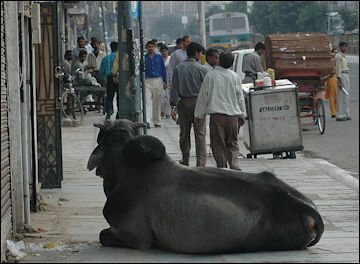
Sacred cows play a big part in Indian politics. The emblem of Indira Gandhi's political party was a calf suckling a mother cow. Mohandas K. Gandhi wanted a total ban on cow slaughter and advocated a cow bill of rights in the Indian constitution. During the Mad Cow Disease crisis in Britain, the World Hindu Council announced that it would offer "religious asylum" to any cattle chosen for extermination. There is even an All-Party Cow Protection Campaign Committee.
Laws against the slaughter of cattle have been a cornerstone of the Hindu nationalist platform. They are also seen as a means to vilify Muslims, who are sometimes stigmatized as cow-killers and cow eaters. In January 1999, a government commission was set up to look after the nation's cows.
Every year, there are bloody riots in India involving Hindus who have accused Muslims of being cow killers. One riot in Bihar in 1917, left 30 people and 170 Moslem villages looted. In November, 1966, about 120,000 people led by holy men smeared with cow dung protested cow slaughter in front of the Indian Parliament building and 8 people were killed and 48 were injured in the riot that followed.
Cow Shelters and Laws Protecting Sacred Cows
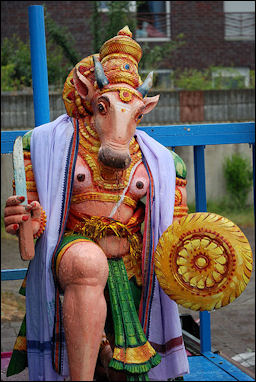
With the exception of two states, the slaughter of cows is forbidden by Indian law. Bulls, bullocks and she buffalos are protected up to 15 years of age. The two states were slaughtering cows is allowed is Kerala, which has many Christians and is known for liberal thinking, and West Bengal, which is predominately Muslim.
It is okay yell and curse at a sacred cow, push, kick and hit them with a stick, but you can never, never injure or kill one. According to an ancient Hindu verse anyone who plays a role in the killing of a cow will "rot in hell for many years as their hairs on the body of the cow so slain. Drivers that hit a sacred cow take off after the collision if they know what is good for them before the mob forms. Muslims often have to especially careful.
In some parts of India killing a cow accidently can result in a multi-year prison sentence. One man who accidently killed a cow when he hit it with a stick after it raided his granary was found guilty of “gao hatya” “cow murder” by a village council and had to pay a substantial fine and host a banquet for all the people in his village. Until he fulfilled these obligations he was excluded from village activities and was unable marry off his children. It took the man more than a decade to pay of the fine and raise the money for the banquet. [Source: Doranne Jacobson, Natural History, June 1999]
In March, 1994, New Delhi's new fundamentalist Hindu government approved a bill banning the slaughter of cows and the sale or possession of beef. Those arrested for possession of beef faced prison sentences up to five years and fines of up to $300. Police were given the authority to raid shops without notice and hold people charged with cow murder in jail without bail.
RECOMMENDED BOOKS:
“The Sacred Cow and the Abominable Pig: Riddles of Food and Culture” by Marvin Harris Amazon.com ;
“Cow Care in Hindu Animal Ethics” by Kenneth R. Valpey Amazon.com ;
“Hindu Rites And Rituals: Origins And Meanings” by K V Singh Amazon.com ;
“Hindu Rites, Rituals, Customs & Traditions” by Prem P. Bhalla Amazon.com ;
“Shiva Beginner Puja” by Swami Satyananda Saraswati and Shree Maa Amazon.com ;
"An Introduction to Hinduism" by Gavin Flood Amazon.com ;
“Hinduism for Beginners - The Ultimate Guide to Hindu Gods, Hindu Beliefs, Hindu Rituals and Hindu Religion” by Cassie Coleman Amazon.com ;
"The Hindus: An Alternative History" by Wendy Doniger; Amazon.com ;
“Myths and Symbols in Indian Art and Civilization” by Heinrich Zimmer (Princeton University Press, 1992) Amazon.com
Wandering Cows and Cow Shelters in India
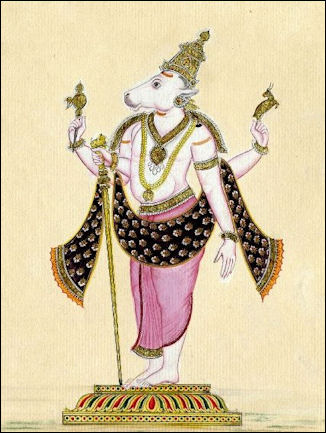
Many of the cows found wandering the streets are dairy cows who have gone dry and been released. Cattle left to wander are supposed to be left to die naturally, with their meat consumed by dogs and vultures, and the skins licensed by Untouchable leatherworkers. But that is not always what happens. To keep traffic flowing cows have been banished from the streets of Bombay and quietly picked up in New Delhi and taken to sites outside the city.
The 1994 bill mentioned above also established 10 "cow shelters" in Delhi — home of an estimated 150,000 cows at that time — for old and sick cows. Supporters of the bill said, "We call the cow our mother. So we need to protect our mother." When the bill was passed legislators shouted "Victory to mother cow." Critics said it was an attempt to restrict the eating habits of non-Hindus. Between 1995 and 1999, BJP government appropriated $250,000 and set aside 390 acres of land for “gosadans” ("cow shelters). Of the nine cow shelters that have been set up only three were really functioning in 2000. As of 2000, about 70 percent of the 50,000 or so cattle brought the shelter had died.
Sometimes wandering cattle are not so benign. In the early 2000s, three sacred bulls ran amok in a small villages south of Calcutta, goring to death four people and injuring 70 others. The bulls were give as a gift to a local Shiva temple but became aggressive over the years and became found of rampaging through the local market and tearing up stalls and attacking people.
Killing Sacred Cows in India
It is estimated that about 20 million cattle die every year. Not all die natural deaths. Large numbers of cattle are disposed off every year as evidenced by India's huge leathercraft industry. Some cities have measures allowing the slaughter of obstructive cattle. "Many are picked up by truck drivers who take them to illegal slaughter houses where they are killed “the favored method is slitting their jugular veins. Often the slaughterers staart skinning the animals before they are dead.
Many calves are killed soon after they are born. On average for every 70 cows for every 100 oxen. Since an equal number of young cows and oxen are born, this mean that something is happening to the cows after they are born. Oxen are more valuable than cows because they are stronger and used to pull plows.
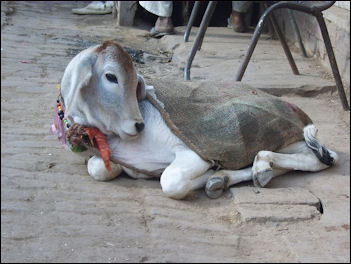
Unwanted cows are gotten ride in numerous ways that apparently do not conflict with taboo against slaughtering cattle: young ones have a triangular yokes placed around their necks which caused them to jab their mothers udder and get kicked to death. Older ones are simply tied to a rope a left to starve. Some cows are also quietly sold to middlemen who take them to Christian or Muslim slaughterhouses.
The slaughter of cows had traditionally been done by Muslims. Many butchers and meat "wallahs" have reaped good profits from discreetly delivering beef to meat eaters. Hindus play their part. Hindu farmers sometimes allow their cattle to taken for slaughter. Much of the meat is smuggled to the Middle East and Europe. During the mad cow disease crisis much of the slack caused by a lack of beef production in Europe was made up for by India. Leather products from India end up in leather goods in the Gap and other stores.
Trafficking of Sacred Cows in India
Most of the cow slaughtering in India is done in Kerala and West Bengal. There is huge trafficking network for from cattle other states taken to Kerala and West Bengal. An official with the Ministery of Social Justice and Empowerment, told the Independent. "The ones going to West Bengal go by truck and train and they go by the millions. The law say you cannot not transport more than four per truck but they are putting in up to 70. When they go by train, each wagon is supposed to hold 80 to 100, but the cram up to 900. I've seem 900 cows coming of the wagon of a train, and 400 to 500 of them came out dead." [Source: Peter Popham, Independent, February 20, 2000]
The official said the trade exists through corruption. "An illegal organization called the Howrah Cattle associate fakes permits saying the cattle of meant for agricultural purposes, for plowing fields, or for milk. The stationmaster at the point of embarkation gets 8,000 rupees per train-load for certifying the cows are healthy and being used for milk. The government vets get X amount for certifying them as healthy. The cattle are unloaded just before Calcutta, at Howrah, then beaten and taken across to Bangladesh."
Bangladesh is the largest exporter of beef in the region even though it has virtually no cattle of its own. Between 10,000 and 15,000 cows cross the border every day. You can reportedly figure out the route the took by following their trail of blood.
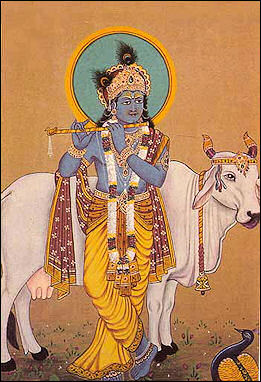
Krishna with a Nandi bull The official said. "On the route to Kerala they don't bother with trucks or trains; they tie them and beat them and take them on foot, 20,000 to 30,000 per day." The animals are reportedly not allowed to drink and eat and are driven forward with blows to their hips, where they have no fat to cushion the blows. Those that fall down and refuse to move have chile pepper rubbed in their eyes."
"Because they have walked and walked, and walked the cattle have lost a lot of weight, so to increase the weight and the amount of money they will receive, the traffickers make them drink water laced with copper sulfate, which destroys their kidneys and make it impossible for them to pass water’so when they are weighed they have 15 kg of water inside them and are in extreme agony."
The cattle are sometimes slaughtered using primitive and cruel techniques. In Kerala they are often killed with a dozen hammer blows that turn their heads into a pulpy mess. The slaughterhouses workers claim that the meat of cows killed in this fashion taste sweeter than cows killed by slits to their throats or are killed with stun gins. "Cattle salesmen reportedly slashed the legs of healthy cattle to claim they were disable and eligible for slaughter."
Image Sources: Wikimedia Commons
Text Sources: “World Religions” edited by Geoffrey Parrinder (Facts on File Publications, New York); “Encyclopedia of the World’s Religions” edited by R.C. Zaehner (Barnes & Noble Books, 1959); “Encyclopedia of the World Cultures: Volume 3 South Asia “ edited by David Levinson (G.K. Hall & Company, New York, 1994); “The Creators” by Daniel Boorstin; “A Guide to Angkor: an Introduction to the Temples” by Dawn Rooney (Asia Book) for Information on temples and architecture. National Geographic, the New York Times, Washington Post, Los Angeles Times, Smithsonian magazine, Times of London, The New Yorker, Time, Newsweek, Reuters, AP, AFP, Lonely Planet Guides, Compton’s Encyclopedia and various books and other publications.
Last updated December 2023
